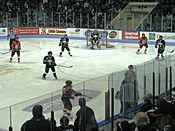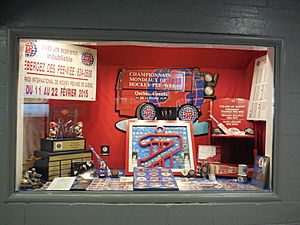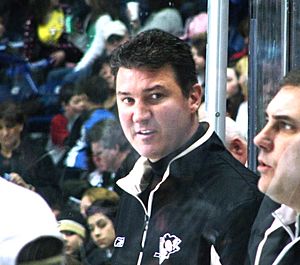Quebec International Pee-Wee Hockey Tournament facts for kids
Quick facts for kids Quebec International Pee-Wee Hockey Tournament |
|
|---|---|
 |
|

2009 tournament game action
|
|
| Genre | Minor ice hockey |
| Frequency | Annually in February |
| Venue | Videotron Centre |
| Location(s) | Quebec City, Quebec |
| Country | Canada |
| Inaugurated | 1960 |
| Founders | Gérard Bolduc, Paul Dumont and others |
The Quebec International Pee-Wee Hockey Tournament (also known as French: Tournoi international de hockey pee-wee de Québec) is a super exciting yearly ice hockey event for young players in Quebec City, Canada. It's often called the "Pee-Wee World Championships"! This tournament started way back in 1960. It was created to let young hockey players, who are usually under 12 years old, compete against teams from all over the world.
The tournament happens every February. It used to be held at the Quebec Coliseum for 56 years. Now, it takes place at the Videotron Centre. This amazing event helps raise money for a local charity called Patro Roc-Amadour. Most of the work is done by dedicated volunteers. Many famous hockey players, over 1,200 of them, have played in this tournament before joining the National Hockey League (NHL).
Contents
Tournament History
How the Tournament Began (1960-1974)
The idea for this tournament came from Gérard Bolduc. He traveled with youth hockey teams to other tournaments. In 1960, he started the Quebec International Pee-Wee Hockey Tournament. He worked with Paul Dumont and others to make it happen. Bolduc was the first president of the tournament until 1974. The tournament quickly became a fun part of the yearly Quebec Winter Carnival.
The very first tournament in 1960 had 28 teams. Most were from Quebec City. But teams also came from places like Boston and Newfoundland. The first game was played on February 20, 1960, at Quebec Arena. People in Quebec City loved the event. It was for a good cause and was the first time youth hockey was played in such a big arena. Over 12,500 fans watched in the first week! The final game was moved to the Quebec Coliseum. It drew 7,235 fans. The first champion team was the Scarborough Lions.
From 1960 onwards, every tournament was held at the Quebec Coliseum. The tournament had four different skill levels: AA, A, B, and C. There was one overall champion. By 1962, the tournament grew to 54 teams. Teams came from other parts of Canada and the United States. Hockey legend Guy Lafleur played in three tournaments from 1962 to 1964. He scored an amazing 64 goals! A local team called the Quebec Beavers became a crowd favorite. Their coach was Martin Madden.
In 1965, the Gérard Bolduc trophy was created. It was given to the winners of the AA division. In 1969, the tournament celebrated its 10th anniversary. A book was written about its amazing story. A team from Princeville, Quebec, won the championship in 1969. They were the first winners from the host province.
The 1970s started with 102 teams. New teams came from France and West Germany. Gérard Bolduc even tried to get a team from the Soviet Union to play. In the 1974 tournament, a young player named Wayne Gretzky scored 26 goals for his Brantford team. After that year, Bolduc stepped down as president.
Growth and New Divisions (1975-1999)
In 1975, Alex Légaré became the new president. He led the tournament until 1999. In 1976, a new International Cup division was added. Légaré wanted the tournament to be more independent. So, it moved away from being a direct partner with the Quebec Winter Carnival. He also started the American Cup in 1980 and the Quebec Cup in 1981. These were later combined into the International Cup.
The tournament celebrated its 25th anniversary in 1984. A special plaque was put up at the Quebec Coliseum. That year, Manon Rhéaume made history. She became the first female goalie to play for a boys' team in the tournament. The rules were even changed to let her play! In 1989, teams from the Soviet Union and Japan joined the tournament. The final game in 1990 had almost 8,000 fans.
The 1990s saw strong teams from Europe. This made the tournament even more exciting. By its 35th anniversary in 1994, the tournament had 115 teams from 12 countries. Nearly 200,000 people came to watch! In 1999, a new attendance record was set. Over 211,000 people watched the games.
Modern Era (2000-Present)
In 2001, the tournament dates were changed. They no longer happened at the same time as the Quebec Winter Carnival. This was done to get even more people to attend. The 50th anniversary in 2009 was a big celebration. There was a special "legends game." Former players who had retired from professional hockey came back to play. In 2011, Australia sent a team. This was the first team from Oceania to play in the tournament.
The 57th tournament in 2016 moved to its new home, the Videotron Centre. This was after playing every year before at the Quebec Coliseum. In 2016, a special all-girls team from Quebec played in the AA division. This was the first time a team made entirely of girls participated. Canadian Olympic hockey players Caroline Ouellette, Marie-Philip Poulin, and Kim St-Pierre coached the team. Before 2016, girls' teams had only played in exhibition games.
By 2016, over 300 teams wanted to register for the tournament. This was a 20% increase from 2015! Many teams come from Quebec. Because so many teams want to play, about 20% of applications are turned down. Sadly, in 2016, teams from Russia were not allowed to play. This was because some players and coaches were disrespectful to volunteers. Russian teams were also not allowed in 2007 for similar reasons.
In 2020, the tournament organizers announced that the 2021 tournament was canceled. This was due to the global COVID-19 pandemic in North America.
Community Impact
The tournament is famous worldwide. This is thanks to its amazing volunteers and staff. One organizer said that the "soul of this tournament is the volunteers, the sponsors and the crowd." Money raised from the tournament has helped the Patro Roc-Amadour charity since 1960. In the first 50 years, over $2.1 million was given to the foundation! Patro Roc-Amadour also has a museum about the tournament. It shows pictures and trophies. The tournament brings a lot of money to the community. It was estimated to bring $14 million in 2008 and $17 million by 2016.
Player Experience
Players often say the tournament is a "once-in-a-lifetime opportunity." For many, it's their first time playing in a huge arena. They get to play in front of crowds of 10,000 fans or more! For European players, it's sometimes their first trip to North America.
Tournament organizers try to find host familys for visiting athletes. This helps lower the high cost of travel. Some teams have to do a lot of fundraising to afford to come.
The tournament also lets players experience French Canadian culture. They get to see Old Quebec, the Citadelle of Quebec, and the Winter Carnival. They can also try other winter sports. Players meet other young people from around the world. They often trade and collect lapel pins as souvenirs.
Notable Participants
The tournament keeps a list of former players who later played in the National Hockey League (NHL) or the World Hockey Association. As of 2018, this list includes 1,246 people! Out of the 100 Greatest NHL Players list from 2017, twenty of them played in this tournament.
Famous NHL Players Who Played in the Tournament
| Player | Season(s) | Team(s) |
|---|---|---|
| Brad Park | 1960 | Scarborough Lions |
| Gilbert Perreault | 1961, 1962, 1963 | Victoriaville |
| Guy Lafleur | 1962, 1963, 1964 | Rockland / Thurso |
| Marcel Dionne | 1962, 1963, 1964 | Drummondville |
| Mike Bossy | 1969 | Montreal C.J.M.S. |
| Mike Gartner | 1972 | Christie |
| Denis Savard | 1973, 1974 | Verdun |
| Wayne Gretzky | 1974 | Brantford |
| Paul Coffey | 1974 | Christie |
| Adam Oates | 1975 | Kings |
| Ron Francis | 1975, 1976 | Sault Ste. Marie |
| Scott Stevens | 1976 | Kitchener |
| Pat LaFontaine | 1977 | Waterford |
| Steve Yzerman | 1977 | Nepean |
| Mario Lemieux | 1977, 1978 | Ville-Émard |
| Brett Hull | 1977 | Winnipeg Monarchs |
| Patrick Roy | 1977, 1978 | Québec Centre |
| Mike Modano | 1982 | Detroit Little Caesars |
| Brendan Shanahan | 1982 | Mississauga Reps |
| Eric Lindros | 1985 | Toronto Marlboros |







